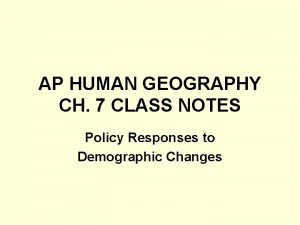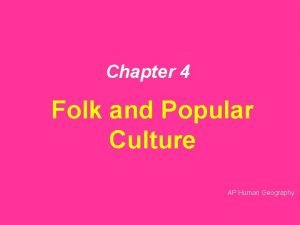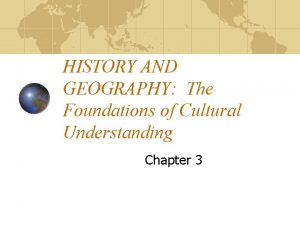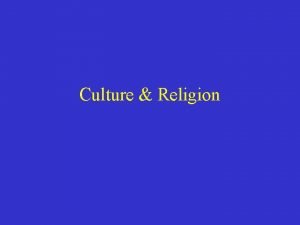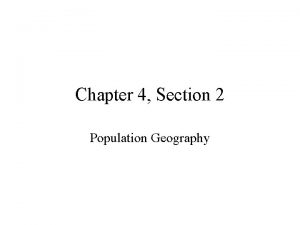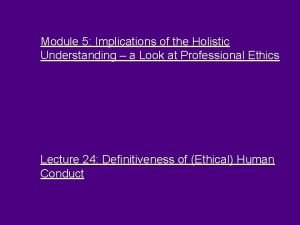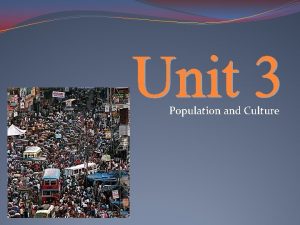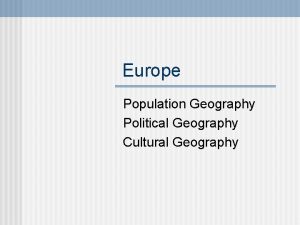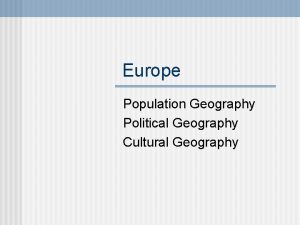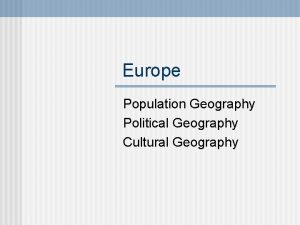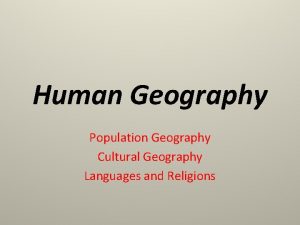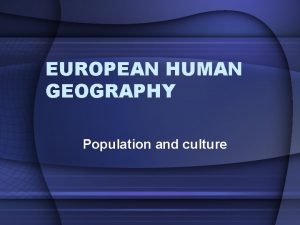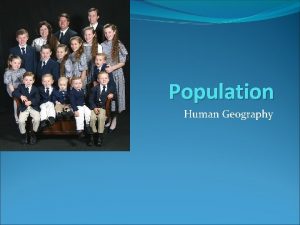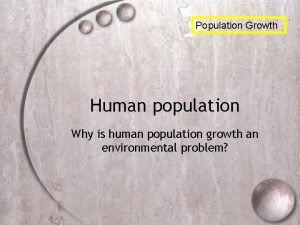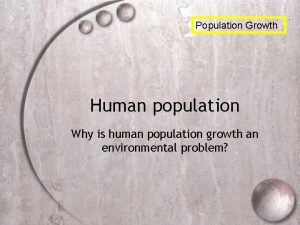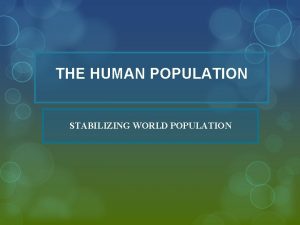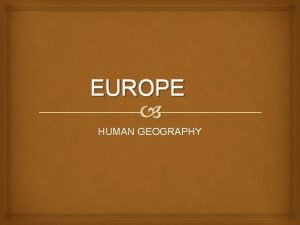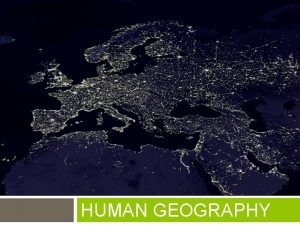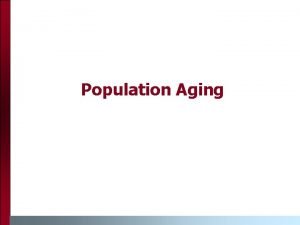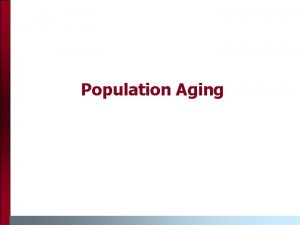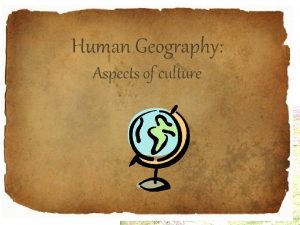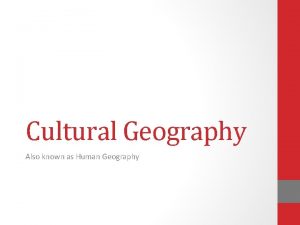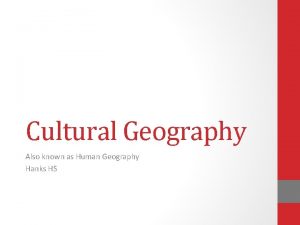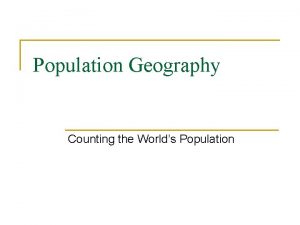Population and Culture Human Geography is also the






























- Slides: 30

Population and Culture

Human Geography is also the study of languages, religions, customs, economics, and political systems Spatial perspective Ecological perspective Historical perspective Economic perspective

Focus Question What is culture?

The Nature of Culture What are some of the elements of culture? If you had to think of Greenwood as a culture, what would you choose to describe it? • Identify where the following items originated: • Hotdogs and hamburgers • Halloween • Democracy • Chocolate • Number system • Paper money • hockey

The Nature of Culture is reflected in both material and nonmaterial ways. Culture Hearth Refers to a place where certain ideas begin Language “Cornerstone” of culture – holds a group of people together Religion Monotheistic vs. Polytheistic Cultural Landscapes Social Organization Women and Minorities

Nacirema Body rituals of the Nacirema people How does our cultural worldview influence and inform our perception of people from other cultures? How can we benefit from understanding our own cultural worldview and how it affects our relationships with other cultures?

• What about the article resonates with you personally? • What is the father asking his son’s teacher to do? • What are the background knowledge and skills Wind-Wolf brings to the classroom? • How might the teacher capitalize on Wind-Wolf’s knowledge and skills? • After reading this article, why is having cultural awareness important?

Culture Change Culture change can be both internal and external New technologies or the way of doing something Cultural Convergence When the aspects of one culture come in contact with another culture Mexican Food/Music Videos/Clothing Diffusion – cultural element is transmitted across a distance. Typically through migration Cultural Divergence Restriction of a culture from outside contact.


Establishing a Settlement • You, along with 200 people have came to this deserted island in hopes of establishing a settlement and creating a society. • Year – 2012, you have no technology only your current knowledge. You are designated as the expedition leader and must decide where to build. • Analyze the map of the island, identifying key land features, natural resources, distance things are from one another, and climate type. 1. Choose three (3) locations that you feel are best for your group to settle and identify that location on the map. 2. On the back of the map, explain what influences your decision to settle in each location and describe how your society will cope with the environment/ecosystems. 3. Predict how a growing population would affect each settlement location, and describe what your settlement would do to address population increase.

What factors lead people to live where they do?

Focus 1. Why is population density distributed unevenly around the world? 2. What are some possible effects of population growth?

Big World…. Little Living Space 7 Billion people live on the Earth today 2/3 rds of the Earth is water ½ of land is uninhabitable

Environment Adapting to your surroundings Clothing Buildings Technology Altering the physical landscape

Population Density: average number of people in a square mile

Population Growth Modern technology Allows for more food to be produced Allows for better health care What will the effects of rapid population growth be? Immigrants vs. Emigrants (Birth Rate vs. Death Rate)





Movement and Settlement 1. 2. 3. 4. 5. 6. Beachcombing Fishing/Hunter-Gatherers Agriculture and Civilization Trade and Exploration Industrial Age Transportation and Communication





Urbanization The growth of city populations Rural countryside

Urban Planning Concentric Zone vs. Sectors


Human Footprint

World Urban Areas Population and Density: A 2012 Update Annotations – 10 Points Mapping Megacities and Population Densities – 10 Points Reflection – 20 Points -Write a reflection of the information in the article, 1 -2 pages. Describe your findings…what stood out to you, what surprised you? Also, make sure and answer the two focus questions at the beginning of the article.
 Ap human geography folk and popular culture
Ap human geography folk and popular culture Eugenic population policies definition ap human geography
Eugenic population policies definition ap human geography Popular culture definition ap human geography
Popular culture definition ap human geography Frq ap human geography format
Frq ap human geography format 5 themes of geography ap human geography
5 themes of geography ap human geography Ap human geography political geography test
Ap human geography political geography test Gni definition ap human geography
Gni definition ap human geography Chapter 4 population ecology worksheet answer key
Chapter 4 population ecology worksheet answer key Population ecology section 1 population dynamics answer key
Population ecology section 1 population dynamics answer key Population ecology section 1 population dynamics
Population ecology section 1 population dynamics Chapter 4 section 1 population dynamics
Chapter 4 section 1 population dynamics Cultural relativism definition
Cultural relativism definition Batch culture vs continuous culture
Batch culture vs continuous culture Indian vs american culture
Indian vs american culture Stab culture and stroke culture
Stab culture and stroke culture Folk culture and popular culture venn diagram
Folk culture and popular culture venn diagram Folk culture and popular culture venn diagram
Folk culture and popular culture venn diagram Explain stab culture and stroke culture
Explain stab culture and stroke culture Folk culture and popular culture venn diagram
Folk culture and popular culture venn diagram Lawn culture method
Lawn culture method Carpet culture microbiology
Carpet culture microbiology Surface culture deep culture and esol
Surface culture deep culture and esol History and geography: the foundations of culture
History and geography: the foundations of culture Taliban vs western values ap human geography
Taliban vs western values ap human geography Chapter 4 section 2 population geography
Chapter 4 section 2 population geography Definitiveness of ethical human conduct
Definitiveness of ethical human conduct Individual culture traits combine to form culture patterns.
Individual culture traits combine to form culture patterns. Batch culture vs continuous culture
Batch culture vs continuous culture Characteristics of collectivism
Characteristics of collectivism Sub culture vs counter culture
Sub culture vs counter culture Adaptive culture from inert culture
Adaptive culture from inert culture

